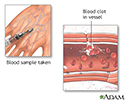Von Willebrand disease
Bleeding disorder - von Willebrand
Von Willebrand disease is the most common hereditary bleeding disorder .
Bleeding disorder
Bleeding disorders are a group of conditions in which there is a problem with the body's blood clotting process. These disorders can lead to heavy a...
Causes
Von Willebrand disease is caused by a deficiency of von Willebrand factor. Von Willebrand factor helps blood platelets clump together and stick to the blood vessel wall, which is necessary for normal blood clotting. There are several types of von Willebrand disease.
Platelets
A platelet count is a lab test to measure how many platelets you have in your blood. Platelets are parts of the blood that help the blood clot. The...
A family history of a bleeding disorder is the primary risk factor.
Symptoms
Symptoms may include:
- Abnormal menstrual bleeding
-
Bleeding of the gums
Bleeding of the gums
Bleeding gums can be a sign that you have or may develop gum disease. Ongoing gum bleeding may be due to plaque buildup on the teeth. It can also b...
Read Article Now Book Mark Article -
Bruising
Bruising
Bleeding into the skin can occur from broken blood vessels that form tiny red dots (called petechiae). Blood also can collect under the tissue in la...
 ImageRead Article Now Book Mark Article
ImageRead Article Now Book Mark Article - Nosebleeds
-
Skin rash
Skin rash
Rashes involve changes in the color, feeling or texture of your skin.
 ImageRead Article Now Book Mark Article
ImageRead Article Now Book Mark Article
Note: Most women with heavy or prolonged menstrual bleeding do not have von Willebrand disease.
Exams and Tests
Von Willebrand disease may be hard to diagnose. Low von Willebrand factor levels and bleeding do not always mean you have von Willebrand disease.
Tests that may be done to diagnose this disease include:
-
Bleeding time
Bleeding time
Bleeding time is a medical test that measures how fast small blood vessels in the skin stop bleeding.
 ImageRead Article Now Book Mark Article
ImageRead Article Now Book Mark Article - Blood typing
- Factor VIII level
- Platelet function analysis
-
Platelet count
Platelet count
A platelet count is a lab test to measure how many platelets you have in your blood. Platelets are parts of the blood that help the blood clot. The...
Read Article Now Book Mark Article - Ristocetin cofactor test
- Von Willebrand factor specific tests
Treatment
Treatment may include DDAVP (desamino-8-arginine vasopressin), a medicine to raise von Willebrand factor level and reduce the chances for bleeding.
However, DDAVP does not work for all types of von Willebrand disease. Tests should be done to determine what type of von Willebrand you have. If you are going to have surgery, your doctor may give you DDAVP before surgery to see if your von Willebrand factor levels increase.
The drug Alphanate (antihemophilic factor) is approved to decrease bleeding in people with the disease who must have surgery or any other invasive procedure.
Blood plasma or certain factor VIII preparations may also be used to decrease bleeding.
Outlook (Prognosis)
Bleeding may decrease during pregnancy. Women who have this condition usually do not have excessive bleeding during childbirth.
This disease is passed down through families. Genetic counseling may help prospective parents understand the risk to their children.
Possible Complications
Bleeding may occur after surgery or when you have a tooth pulled.
Aspirin and other nonsteroidal anti-inflammatory drugs (NSAIDs) can make this condition worse. DO NOT take these medicines without first talking to your health care provider.
When to Contact a Medical Professional
Call your provider if bleeding occurs without reason.
If you have von Willebrand disease and are scheduled for surgery or are in an accident, be sure you or your family notify the providers about your condition.
References
Flood VH, Scott JP. Von Willebrand disease. In: Kliegman RM, Stanton BF, St Geme JW, Schor NF, eds. Nelson Textbook of Pediatrics . 20th ed. Philadelphia, PA: Elsevier; 2016:chap 477.
James P, Rydz N. In: Hoffman R, Benz EJ Jr, Silberstein LE, Heslop HE, Weitz JI, Anastasi J, eds. Hematology: Basic Principles and Practice . 6th ed. Philadelphia, PA: Elsevier Churchill Livingstone; 2013:chap 140.
Nichols WL. Von Willebrand Disease and hemorrhagic abnormalities of platelet and vascular function. In: Goldman L, Schafer AI, eds. Goldman's Cecil Medicine . 25th ed. Philadelphia, PA: Elsevier Saunders; 2016:chap 173.
-
Blood clot formation - illustration
Blood clotting normally occurs when there is damage to a blood vessel. Platelets immediately begin to adhere to the cut edges of the vessel and release chemicals to attract even more platelets. A platelet plug is formed, and the external bleeding stops. Next, small molecules, called clotting factors, cause strands of blood-borne materials, called fibrin, to stick together and seal the inside of the wound. Eventually, the cut blood vessel heals and the blood clot dissolves after a few days.
Blood clot formation
illustration
-
Blood clots - illustration
Blood clots (fibrin clots) are the clumps that result when blood coagulates.
Blood clots
illustration
-
Blood clot formation - illustration
Blood clotting normally occurs when there is damage to a blood vessel. Platelets immediately begin to adhere to the cut edges of the vessel and release chemicals to attract even more platelets. A platelet plug is formed, and the external bleeding stops. Next, small molecules, called clotting factors, cause strands of blood-borne materials, called fibrin, to stick together and seal the inside of the wound. Eventually, the cut blood vessel heals and the blood clot dissolves after a few days.
Blood clot formation
illustration
-
Blood clots - illustration
Blood clots (fibrin clots) are the clumps that result when blood coagulates.
Blood clots
illustration
Review Date: 2/1/2016
Reviewed By: Todd Gersten, MD, Hematology/Oncology, Florida Cancer Specialists & Research Institute, Wellington, FL. Review provided by VeriMed Healthcare Network. Also reviewed by David Zieve, MD, MHA, Isla Ogilvie, PhD, and the A.D.A.M. Editorial team.


